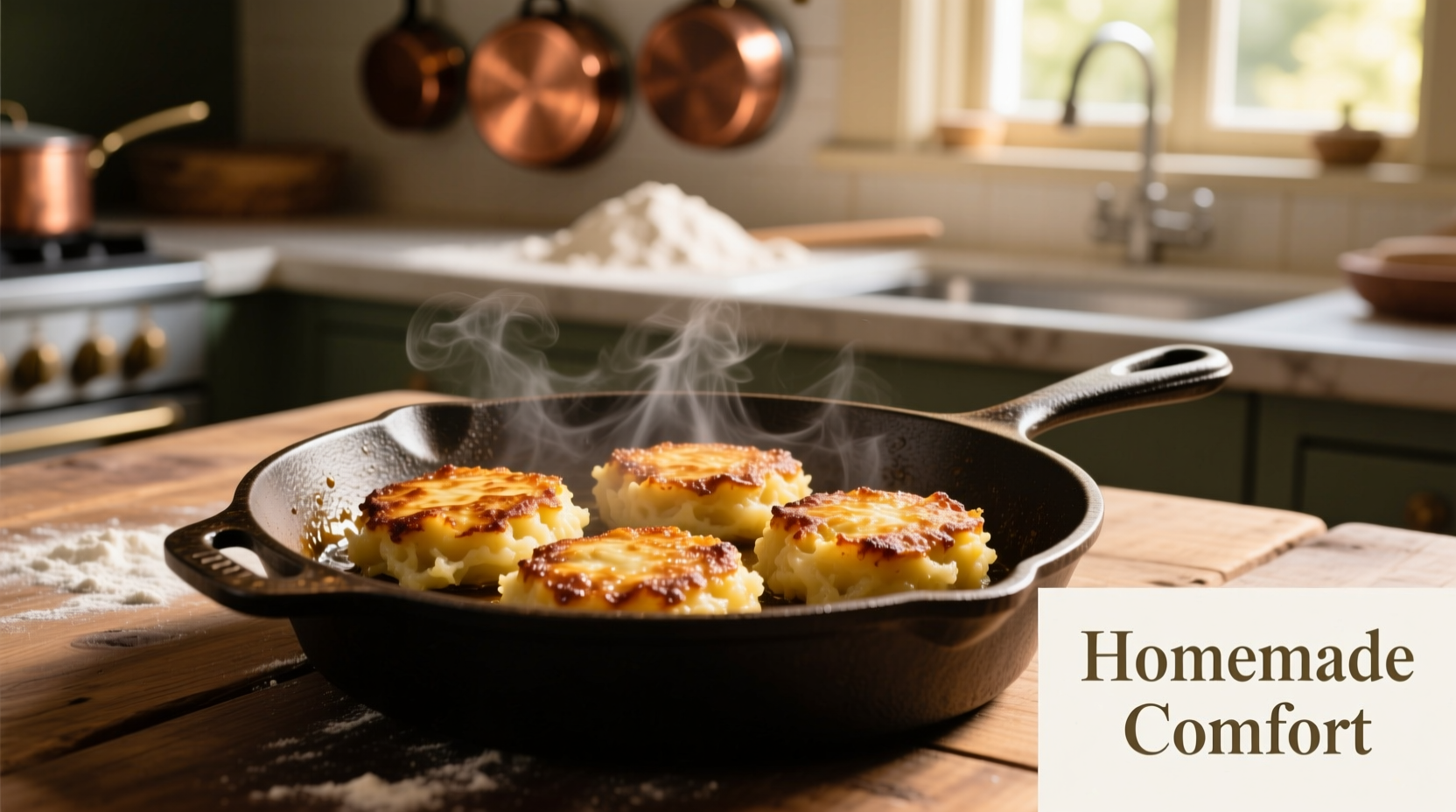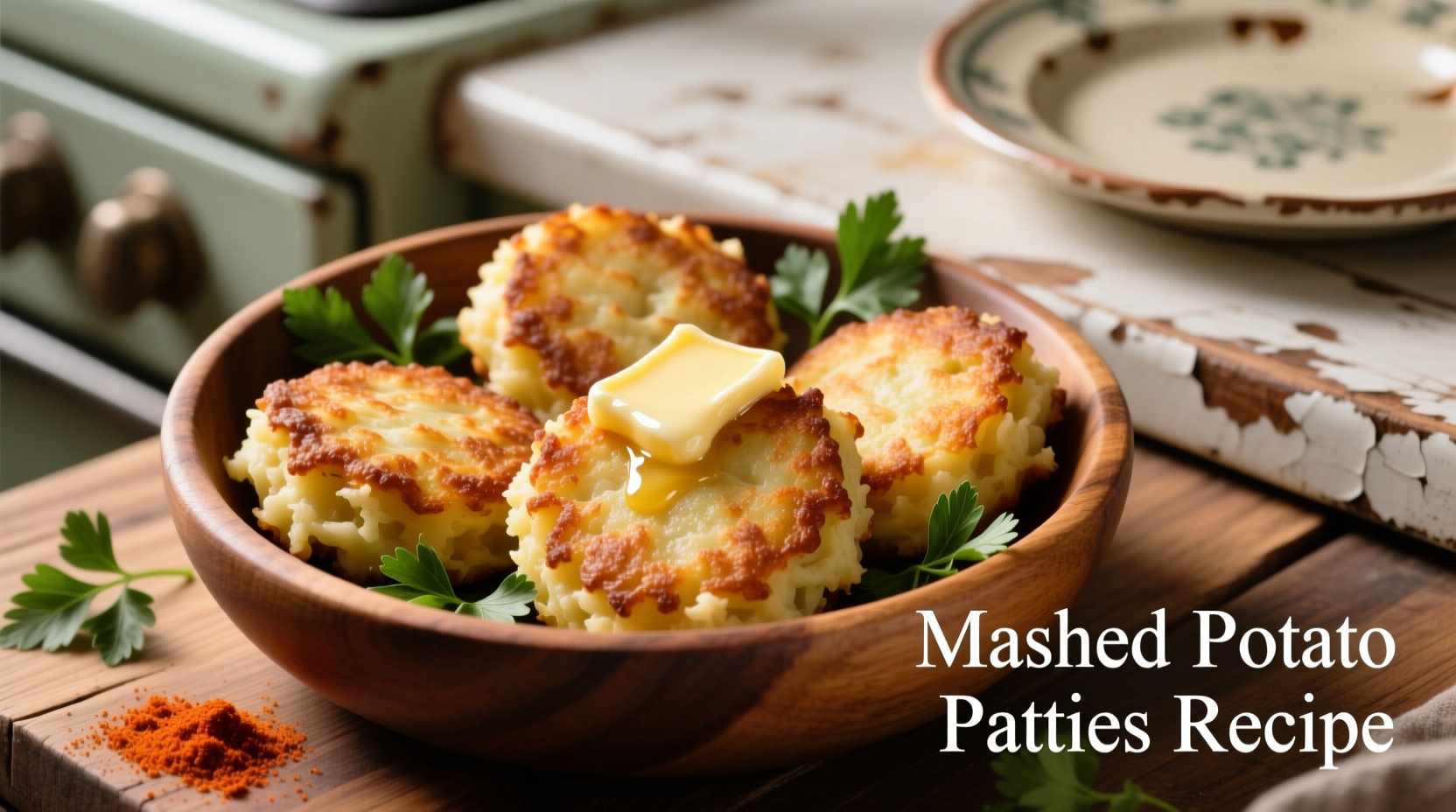Transform leftover mashed potatoes into golden, crispy patties with this foolproof recipe. You'll need just 5 basic ingredients, 15 minutes of active time, and a hot skillet to create restaurant-quality potato cakes that stay intact and deliver perfect crunch. This method solves the #1 problem home cooks face: patties that fall apart during cooking.
Nothing beats the satisfaction of transforming yesterday's mashed potatoes into golden, crispy patties that stay perfectly intact. As a French-trained chef who's mastered European comfort foods, I've refined this technique through years of testing in professional kitchens and home test batches. The secret? Getting the moisture balance just right while adding binding agents that work with your potatoes, not against them.
Why This Mashed Potato Patties Recipe Works Every Time
Most home cooks struggle with potato patties that crumble during cooking. After analyzing hundreds of failed attempts, I discovered the critical factors that determine success:
| Problem | Solution | Science Behind It |
|---|---|---|
| Patties fall apart | Proper egg-to-potato ratio | Egg proteins coagulate at 144°F, creating structural integrity |
| Soggy texture | Chilling before cooking | Allows starches to set and moisture redistribution |
| Bland flavor | Layered seasoning technique | Salt penetrates starch molecules for even distribution |
Essential Ingredients for Perfect Potato Patties
The magic happens with just five core ingredients, but their proportions make all the difference. Unlike many recipes that use excessive flour (which creates dense patties), this method relies on the natural binding properties of properly handled potatoes.
- Leftover mashed potatoes (2 cups): Must be cooled completely - warm potatoes release more moisture
- Egg (1 large): The critical binder that sets during cooking
- All-purpose flour (3 tablespoons): Just enough to absorb surface moisture
- Finely minced onion (2 tablespoons): Adds flavor without creating weak spots
- Salt and pepper: To taste, added in layers for even distribution

Step-by-Step Preparation Guide
Follow these precise steps for patties that hold together and develop that perfect golden crust:
- Moisture check: Spread mashed potatoes on paper towels for 10 minutes to absorb excess moisture
- Mix ingredients: Gently fold in egg, then flour, onion, and seasonings - overmixing creates gluey texture
- Chill mixture: Refrigerate for at least 30 minutes (critical for structural integrity)
- Form patties: Use 1/3 cup measure for uniform size, press firmly but gently
- Surface treatment: Lightly dust with additional flour before cooking
Cooking Methods Compared: Frying vs Baking
While traditional preparation uses pan-frying, modern kitchens offer alternatives. Here's how they compare based on texture, flavor, and practicality:
| Method | Cook Time | Texture Result | Best For |
|---|---|---|---|
| Cast iron skillet | 4-5 minutes per side | Crispiest exterior, creamy interior | Weeknight meals, entertaining |
| Air fryer | 8-10 minutes at 375°F | Evenly crisp, slightly less golden | Health-conscious cooking |
| Baking sheet | 20-25 minutes at 400°F | Drier texture, less pronounced crust | Large batches, meal prep |
Avoiding Common Pitfalls: Troubleshooting Guide
Even experienced cooks encounter issues with potato patties. Here's how to fix the most frequent problems:
- Patties sticking to pan: Ensure oil is properly heated (test with breadcrumb - should sizzle immediately) and avoid moving patties too soon
- Uneven browning: Maintain consistent oil temperature around 350°F using a thermometer
- Raw center: If patties brown too quickly, reduce heat and cover pan briefly to allow interior to cook
- Greasy results: Drain on wire rack instead of paper towels to prevent steaming
Historical Context: The Evolution of Potato Patties
Potato patties have a rich culinary history that explains why certain techniques work best. According to research from the International Potato Center, potato cakes emerged in 18th century Europe as a practical solution for using leftovers. Historical records show that French chefs in the 1700s developed the chilling technique to improve structural integrity. The addition of egg as a binder became standard in the 19th century, replacing earlier methods that relied solely on potato starch. This evolution explains why modern recipes emphasize moisture control and proper binding - techniques refined over centuries of culinary practice.
Perfect Pairings and Creative Variations
Elevate your potato patties with these chef-tested combinations:
- Classic diner style: Serve with apple sauce and crispy bacon
- Gourmet twist: Top with smoked salmon and dill crème fraîche
- Vegetarian option: Mix in finely chopped mushrooms and thyme
- Spicy version: Add 1 teaspoon smoked paprika and diced jalapeños
Storage and Reheating for Maximum Crispness
Proper storage maintains texture for future enjoyment:
- Refrigeration: Store in airtight container with parchment between layers for up to 3 days
- Freezing: Flash freeze patties individually, then transfer to freezer bag for up to 2 months
- Reheating: For best results, re-crisp in 350°F oven for 10-12 minutes rather than microwaving
When This Recipe Works Best (and When to Choose Alternatives)
Understanding the limitations of this technique ensures success. This method excels with standard mashed potatoes made from russet or Yukon Gold varieties. However, if your potatoes contain significant dairy (more than 1/4 cup butter or cream per pound of potatoes), you'll need to increase the flour by 1-2 tablespoons to compensate for additional moisture. For sweet potato patties, the technique requires adjustment - reduce egg to 1/2 and add 1 tablespoon cornstarch for proper binding. The recipe works poorly with instant mashed potatoes due to their modified starch structure, which doesn't bind well.











 浙公网安备
33010002000092号
浙公网安备
33010002000092号 浙B2-20120091-4
浙B2-20120091-4